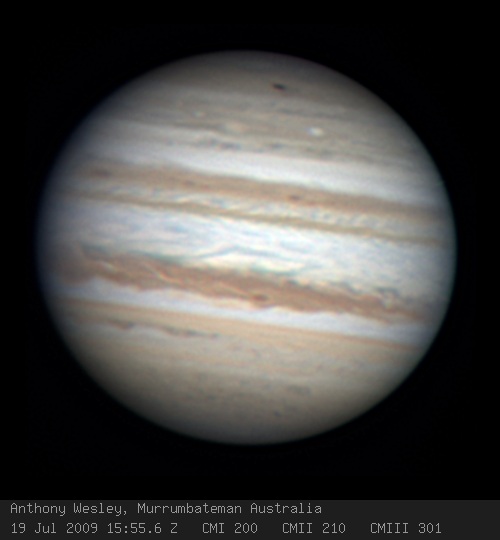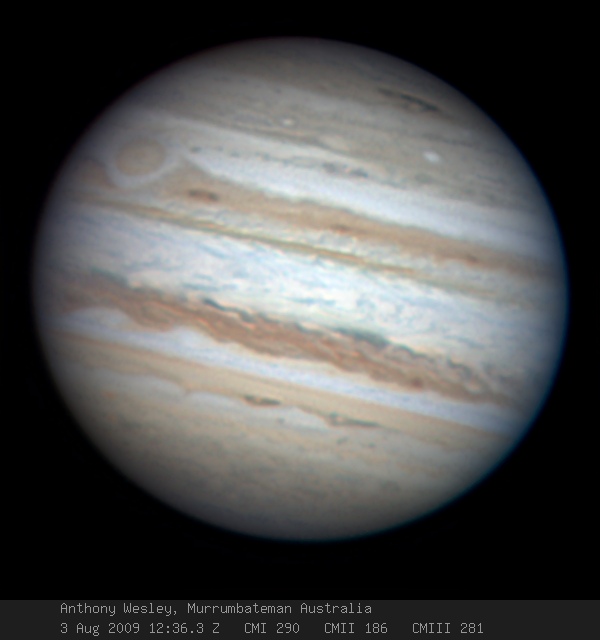
This is a very early image showing the impact mark (top right, on the limb). This image is red channel data only.

I've been slashdotted, and my web server crushed. Now moved this to jupiter.samba.org provided by Tridge - thanks mate, you saved my a$$, you're a legend.
Preliminary image showing a black mark in Jupiters South Polar Region (SPR) which is almost certainly the result of a large impact - either an asteroid or comet - similar to the Shoemaker-Ley impacts in 1994.
Note to Media Images from this page may be used for editorial use only in news stories and publications provided correct attribution is retained.
Date and Time of Report
Dark impact mark first noted at approximately 1330UTC on 19th July 2009 from my home observatory just outside Murrumbateman NSW Australia.
Inspection of earlier images shows the impact visible on the planets limb at 1401UTC.
Equipment and Contact Details
Contact info: Anthony Wesley awesley@smartnetworks.com.au awesley@acquerra.com.au http://www.acquerra.com.au/astro Picture of Anthony and his 14.5 inch scope Scope: Homebrew GEM mounted Newtonian using a 14.5" Royce conical mirror (link to images removed until the slashdot tsumani retreats) Mount: Losmandy Titan Optics: - 14.5" f/5 Royce conical primary - 1/30 wave Antares Optics secondary - Televue 5x powermate , working at 7.7x Camera: Point Grey Research Dragonfly2 mono camera, ICX424al Filters: Astrodon I-Series RGB Capture details: 60 seconds in each filter @ 47fps. Capture software: Coriander Operating System: Linux (Fedora 10 x86) Processing software: Ninox for crop and presort Registax for alignment and stacking Astra Image for deconvolution and RGB align The Gimp for cleanup and captioning.
Update (20th July 1100UT) Glenn Orton from JPL has imaged this site using the NASA Infrared Telescope on Hawaii and confirms that it is an impact site and not a localised weather event.
I started this imaging session on Jupiter at approximately 11pm local time (1300UTC). The weather prediction was not promising, clear skies but a strong jetstream overhead according to the Bureau of Met. The temperature was also unusually high for this time of year (winter), also a bad sign.
The scope in use was my new 14.5" newtonian, in use now for a few weeks and so far returning excellent images.
I was pleasantly surprised to find reasonable imaging conditions and so I decided to continue recording data until maybe 1am local time. By about midnight (12:10 am) the seeing had deteriorated and I was ready to quit. Indeed I had hovered the mouse over the exit button on my capture application (Coriander for Linux) and then changed my mind and decided instead to simply take a break for 30 minutes and then check back to see if the conditions had improved. It was a very near thing.
When I came back to the scope at about 12:40am I noticed a dark spot rotating into view in Jupiters south polar region started to get curious. When first seen close to the limb (and in poor conditions) it was only a vaguely dark spot, I thouht likely to be just a normal dark polar storm. However as it rotated further into view, and the conditions improved I suddenly realised that it wasn't just dark, it was black in all channels, meaning it was truly a black spot.
My next thought was that it must be either a dark moon (like Callisto) or a moon shadow, but it was in the wrong place and the wrong size. Also I'd noticed it was moving too slow to be a moon or shadow. As far as I could see it was rotating in sync with a nearby white oval storm that I was very familiar with - this could only mean that the back feature was at the cloud level and not a projected shadow from a moon. I started to get excited.
It took another 15 minutes to really believe that I was seeing something new - I'd imaged that exact region only 2 days earlier and checking back to that image showed no sign of any anomalous black spot.
Now I was caught between a rock and a hard place - I wanted to keep imaging but also I was aware of the importance of alerting others to this possible new event. Could it actually be an impact mark on Jupiter? I had no real idea, and the odds on that happening were so small as to be laughable, but I was really struggling to see any other possibility given the location of the mark. If it really was an impact mark then I had to start telling people, and quickly. In the end I imaged for another 30 minutes only because the conditions were slowly improving and each capture was giving a slightly better image than the last.
Eventually I stopped imaging and went up to the house to start emailing people, with this image above processed as quick and dirty as possible just to have something to show.
More images will come along from me and many other people in the next few days.
*NOTE* Priority is being given to processing and uploading images as fast as possible, so the image quality is no necessarily as good as it might be. When time permits these images will be replaced by higher quality versions. Anthony
More Images:

This is a very early image showing the impact mark (top right, on the limb). This image
is red channel data only.
It is possible that this is the earliest recorded image of the event.
p.s. The GRS looks nice too, this was my real target for imaging this night!

Note the time on this image was incorrectly labelled as 141134UTC, this has been corrected

Closeup of this region in green light only, from reprocessed data (155537UTC). 3 small dark spots can be seen.
Update: Two of these three small spots may be pre-existing small storms. Thanks to a blink comparison by Brett Hughes.

Same closeup as previous (155537UTC) , now in colour. 3 small dark spots can be seen in addition to the main one, possibly more. Still looking for better quality raw data from other imaging runs around this time.
Update: Two of these three small spots may be pre-existing small storms. Thanks to a blink comparison by Brett Hughes.



Here are images from other amateurs from the first pass of this impact mark, on the same night as my images above. Please note that all images in this section are copyright to their respective owners and not for commercial use without their explicit explicit permission.
July 24 image

Here's an image in good seeing taken from my observatory on July 24, the impact region
has started to spread noticeably.
Also see the Hubble Image taken shortly before this.

In this image we can see the impact debris being spread by Jupiters jetstream winds. The debris field is also starting to break up into
discrete clumps. Some dark material can be seen caught in a local vortex and being pulled around into a circle.